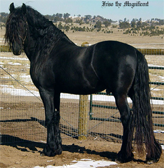Riding your horse may be more difficult in the winter due to the slippery ground and dropping temperatures, but it doesn’t have to be impossible. Keeping your horse in shape and entertained is still necessary, even in the winter months. When you are going for a winter ride, whether indoors or outdoors, remember to use these safety precautions to ensure a safe experience for you and your horse.
Warm Up
Regardless of if you are riding indoors or outdoors, it is important that your horse gets a proper warm up. This ensures a better quality ride, alleviates some of the risks of injury, and is especially important in the cold winter months, due to more joint pressure and muscle fatigue from the cold temperatures. Try a phased warm up for the best results. To start, slowly walk your horse, applying a draped rein and a relaxed frame. Walking around your entire arena or outdoor pen for five to ten minutes will loosen your horse up in preparation for the rest of the workout.
After the walk, ease into a trot to increase your horse’s heart rate and body temperature. Circle the entire arena for a few minutes before accelerating into a lope. In this process, when your horse is beginning to settle in, try bending to supple their muscles. Try figure eights, serpentines, and other exercises in both directions. These warm-ups ensure your horse’s body and mind are ready for the ride ahead.
Keep Warm

Keeping both you and your horse warm are top priorities when riding in the winter. We recommend placing a waterproof wool or fleece quarter sheet between the saddle pad and saddle or over the saddle. You can also try warming up your horse’s bit before your ride. Keep the bit warm when not in use, and try running it under some hot water until it feels warm to the touch. As for the rider, always remember to layer the proper riding equipment to brace the cold temperatures and increased windchill from being higher in the air.
Provide More Grip

Cold is not the only danger in the winter for a horse rider. Ice and bad footing are liable to lead a rider and their horse to injury. Indoor riding is the safest option, but if you are going to brave the wilderness, apply hoof boots, or use pads beneath shoes to avoid concussive injury from stepping on the hard, frozen ground. If your horse experiences pain when walking or standing, they may be suffering from laminitis. Horse Heiro is a year-round cure for laminitis and insulation regulation. Read this article for more information on why your horse needs Heiro year round.
It is also best to avoid riding on trails covered in snow, as they may have potholes, ice, or hidden obstacles that are easy to trip on. If you have an arena, either indoor or outdoor, apply de-icing agents like salt or sawdust to avoid slipping. When on a trail, carry salt or sawdust in your saddlebags in case you encounter a patch of ice.
Slow Down
Cold causes your horse to exert more energy when running, so it is beneficial to slow your pace when riding. Your horse tends to sweat more at higher paces of exercise, and sweat can begin to freeze, causing your horse to develop a chill. A cooler or wicking rug or thatching can also dry some of the sweat. In addition to a slowing the pace, consider shortening the length of your rides completely as to not overwork your horse.
After The Ride

Just like a warm-up, it is important to cool down your horse after the run. Ten to fifteen minutes of light aerobic exercise like walking or leading your horse will relax their muscles and reduce lactic acid buildup in their muscles. Loosen your horse with the same warm-up exercises as before. In addition to stretching, it is important to care for your horse’s legs after a winter ride. Whether indoors or outdoors, use a hoof pick to remove ice and mud from the hooves and around the horseshoes. Clean your horse’s coat too to remove any ice, dirt, or mud, and dry any wetness you come across. After brushing, switch your horse’s saddle for a breathable and wicking wool or fleece quarter sheet to absorb sweat, but leave the girth on to keep them warm.
Use Fresh Food
Because your horse burns more calories in the cold, they need more nutrients in the winter months. Feed your horse fresh hay and avoid excess sugar, which can lead to Insulin Resistance. Since fresh greenery is not available in the winter, your horse cannot get the amounts of vitamin E naturally. To ensure your horse receives this important vitamin, use Health-E, a natural and maximum strength vitamin E supplement. It is the most potent and highest tested supplement in the American market and is also the most cost effective!






; ?>/wp-content/themes/twentyten/img/NMImacLogo_150.jpg)






